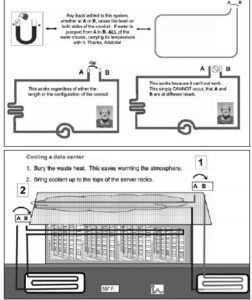The latest scary thing involving the internet is Artificial Intelligence. As with most fast-moving developments, there is hand-wringing and fear-mongering involved in how much our lives and bank accounts will change because of this new scary thing. One documented fact about AI, and other new online-based innovations like iCloud and Bitcoin, is how much more computing power will be necessary to make all this work.
Giant data centers and smaller server farms are being developed anywhere land and water can be found to build them. The good news is they bring a lot of tax revenue to an area. The bad news is the cost of power and need for water hamstrings any local area where these systems are located. Politicians and energy officials are sounding the alarm about this issue. South Carolina Governor Henry McMaster has addressed the subject numerous times.
Most solutions for dealing with increased computing issues involve complicated plans and bags full of money. But a man living in Irmo thinks he has a simple, efficient, and affordable way to help solve this problem…and quite a few others while he’s at it.
John Saavedra is from tiny Narrows, Virginia. He attended school there through high school. He graduated from King College (now University) in Bristol, Tenn., and the University of South Florida in Tampa. After a 30-year career with the U.S. Postal Service in Tampa, transferring to Columbia in the early ’80s, primarily in information systems, John retired in 2008. That summer he flew to China to teach ESL (English as Second Language) at that year’s Summer Olympics.
While traveling to Beijing, John rode his 250cc motor scooter from Irmo to Los Angeles, flew to China and came back the same route. While slowly moving across three deserts both ways, he began thinking about things he could do that would allow him positive activity while retired and help solve issues that came to mind.
His first idea was a clothing design to make the wearer look thinner and slimmer. Although patented and copyrighted, he decided he didn’t want to spend time designing clothing when there were so many more urgent problems that needed fixing. So he focused on saving water and power.
John’s invention for cooling data centers goes back millennia, using a common-sense principle that Aristotle articulated, “Water seeks its own level.” By constructing a loop of pipe partially buried ten feet below ground, and using a small pump, water is circulated through the pipe and transfers heated water from the data center to where the temperature is 55 degrees and brings the resulting colder water to the location of the server, which cools the building.
As of now, he has patents for about 30 projects that do various things to improve the lives of fellow humans in simple and inexpensive ways. In addition to a way to cool data centers, he has a patent that brings winter heat from the sun into a home and reduces heat pump use. He also has a means of turning the moisture from ambient air into clean water, and a saltwater desalination project. He is obviously an idea man.
Part of the drawbacks of coming up with simple, inexpensive ideas is the hesitancy of other folks as to the validity of both his expertise and his sincerity. John is a Christian and thanks God for the ideas. He assumes conviction and his confidence, both in the projects and also the backing fifth-grade level science involved, will encourage others to believe, support, and help develop them. But that’s not the world we live in.
John was an exhibitor at the 2025 S.C. Competes ’25 Fall Summit in Greenville. The event was held at the Peace Center’s Gunter Theatre and involved “Three days in Greenville to mentor, learn, and take action!”
My first introduction to John Saavedra was an email from him expressing interest in a column I wrote about scientists altering natural process to fight climate change. He included some examples of his work. I was skeptical. I always am when approached by anyone offering a too good to be true sounding project. Because he had patents to support his ideas, I did my own research.
I eventually landed on the Department of Energy’s Office of Renewable Energy and Energy Efficiency (EERE). After a little back and forth, I received a response from EERE stating, “What we can offer on background only is yes we fund projects in this area.”
I realize this is government speak, but it implies that John’s project and patent for cooling data centers is possible and valid. Whether it is feasible, financially responsible, and worthy of someone’s precious time and finances is something else.
John told me the response he received at the S.C. Competes ’25 conference was less than what he had hoped for. He also admitted he hadn’t had time to create working models because he kept coming up with new ideas.
History is filled with tales of our great inventors and the things they developed to make life easier or solve problems. The Wright Brothers, A.G. Bell, Henry Ford, and Aristotle are still famous. One wonders how many inventors never were able to get support for their ideas and died without fulfilling their dream? Neither them nor their inventions were ever brought to fruition. And no one calculates how much was lost because of the things we didn’t create.
Even though his climb is long and uphill, John told me, “By the grace of God, some of my best work is still ahead.” History will ultimately decide if that’s true.
For more information on John Saavedra and his projects, visit www.lookforthepower.com.



Loading Comments